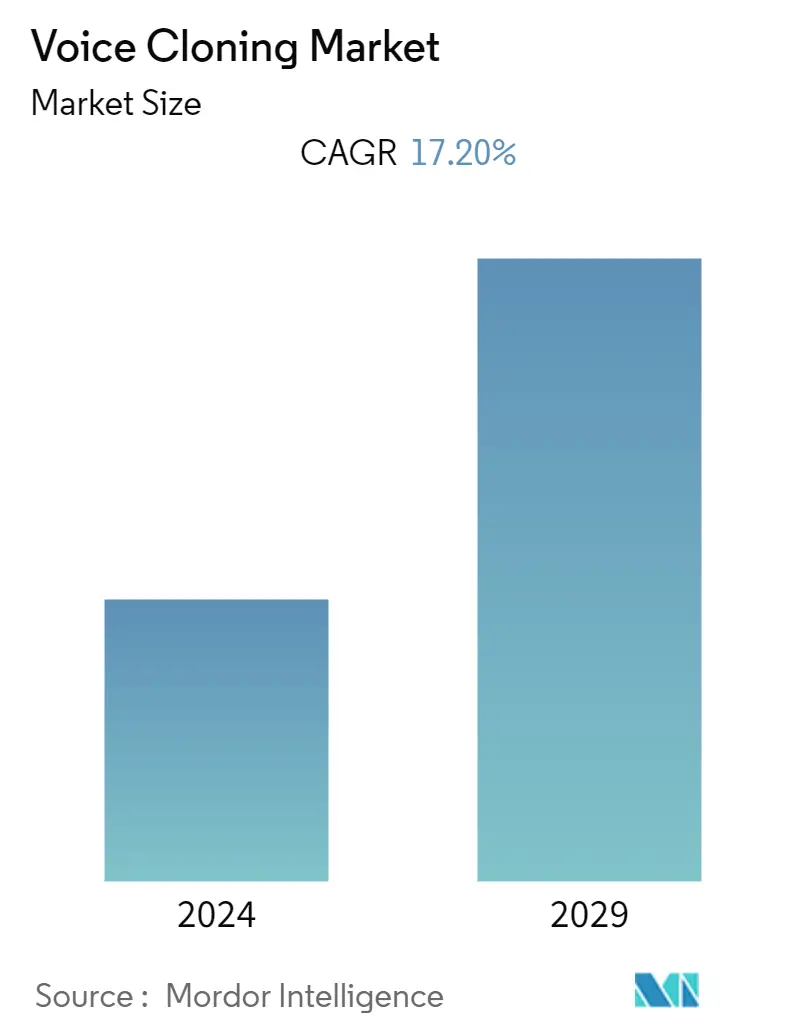Market Size of Voice Cloning Industry

| Study Period | 2019 - 2029 |
| Base Year For Estimation | 2023 |
| CAGR | 17.20 % |
| Fastest Growing Market | Asia-Pacific |
| Largest Market | North America |
| Market Concentration | Medium |
Major Players
*Disclaimer: Major Players sorted in no particular order |
Need a report that reflects how COVID-19 has impacted this market and its growth?
Voice Cloning Market Analysis
The voice cloning market is expected to grow at a CAGR of 17.2% during the forecast period. Voice cloning is the process of synthesizing someone's voice.The voice-cloning solutions and services allow users to generate a computerized version of their voice. These solutions synthesize someone's voice from a few audio samples. Voice cloning is done with the help of artificial intelligence (AI) and machine learning algorithms.
- Enterprises focus on enhancing their customers' experiences by introducing a familiar voice to their products and services. By using these solutions, businesses can form significant long-term relationships with customers by providing them with a considerably better customer experience. Technology providers are also adopting cutting-edge technologies for developing efficient voice cloning solutions. For example, in November last year, The Noddle System, a tool created by Voxello, enabled hospital patients with speech disorders or impairments to contact and converse with their family members and caregivers. Using a microphone, Tenor.ai listens to discussions between patients and doctors in the exam room.
- A voice cloning procedure typically needs a couple of hours of recorded speech to build a dataset and then use the dataset to train a new model. With the growing adoption of AI and machine learning solutions, developers are working hard to shorten the time it takes to complete a voice cloning process.
- However, the malicious ways in which voice cloning methods can be misused are expected to impede the growth of this market. As voice cloning technology can generate fake audio clips that can be manipulated to spread false insights, it has become a significant matter of concern. While the applications for voice cloning technologies, like synthetic voice and speech-to-text, are still expanding, others highlight the technology's moral dilemmas. For instance, a podcast of a conversation between Steve Jobs and Joe Rogan was published by Podcast.ai. The podcast sounds like it features both people's actual voices; however, it was entirely produced by AI.
- Voice cloning companies are also working on making deep fake detection tools so that voice cloning technology isn't abused as much.For instance, in January this year, Microsoft's latest venture into artificial intelligence was VALL-E. This text-to-speech model uses transformers and can "recreate any voice from a three-second sample clip." According to cybersecurity experts, it may be used to launch more convincing phishing attempts and disseminate false information without the proper safeguards.
- At the time of the COVID-19 pandemic, the requirement for digital education platforms kept increasing across the world. When the pandemic was declared in March, the United States sprang into action, and offices, schools, and public areas were shut down. The need for the education system to go online, from K-12 to college, was enormous. E-learning organizations were taking advantage of the opportunity to conduct uninterrupted online classes through voice cloning technology. For example, Voice.com's voice actors did more than 45,000 voice cloning projects for North America's educational institutions.
